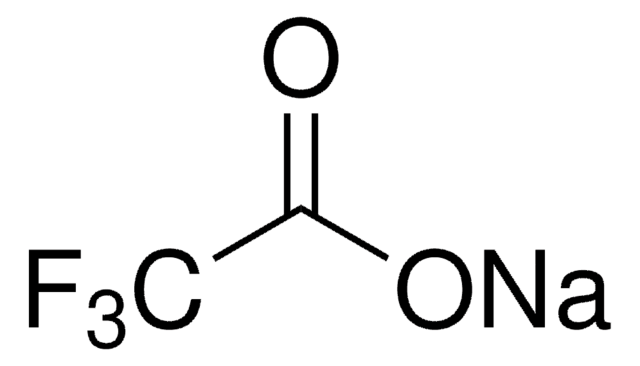5.43833
Acetato de sodio trihydrate
for HPLC LiChropur™
Sinónimos:
Ácido acético sodium salt trihydrate
About This Item
Productos recomendados
Quality Level
form
solid
autoignition temp.
1112 °F
607 °C
technique(s)
HPLC: suitable
pH
7.5-9.2 (20 °C, 50 g/L in H2O)
mp
58 °C
transition temp
flash point >250 °C
density
1.42 g/cm3 at 20 °C
bulk density
900 kg/m3
storage temp.
2-30°C
SMILES string
O.O.O.[Na+].CC([O-])=O
InChI
1S/C2H4O2.Na.3H2O/c1-2(3)4;;;;/h1H3,(H,3,4);;3*1H2/q;+1;;;/p-1
InChI key
AYRVGWHSXIMRAB-UHFFFAOYSA-M
¿Está buscando productos similares? Visita Guía de comparación de productos
Application
- 3D Printing of Supercooled Liquids: Sodium acetate trihydrate is used in 3D printing of supercooled liquids. This research involves modeling and verifying the behavior of supercooled sodium acetate trihydrate in additive manufacturing processes. The study demonstrates its potential in creating complex structures and highlights the thermal properties essential for maintaining supercooling during the printing process. This application is significant for chemists working on advanced manufacturing techniques and material science (Brillinger, Additive Manufacturing, 2023).
- Thermal Energy Storage: Sodium acetate trihydrate is widely used in thermal energy storage systems due to its favorable phase change properties. Studies have shown its effectiveness in storing and releasing thermal energy, which is crucial for applications in solar heating and building energy efficiency. The research also explores the impact of adding water to sodium acetate trihydrate to enhance its thermal stability and latent heat capacity (Beaupere et al., Applied Sciences, 2021).
- Electrical Nucleation of Supercooled Phase Change Composites: Sodium acetate trihydrate is used in the preparation and performance analysis of controllably-triggered electrodes for the electrical nucleation of supercooled phase change composites. This study focuses on improving the efficiency and reliability of phase change materials for thermal management systems. The findings are crucial for developing advanced thermal storage solutions in various industrial applications (Chen et al., SSRN Electronic Journal, 2022).
- Residual Solidification Duration Measurements: Experimental measurements of the residual solidification duration of supercooled sodium acetate trihydrate are conducted to understand its phase change dynamics. This research provides insights into the kinetics of solidification and helps optimize the material′s use in thermal energy storage applications. The study is vital for chemists working on phase change materials and energy storage systems (Beaupere et al., International Journal of Thermal Sciences, 2020).
- Composite Phase Change Materials: Sodium acetate trihydrate is combined with pyrolytic carbon residue to create composite phase change materials. This research aims to improve the thermal cycling performance and reduce the undercooling and phase separation issues commonly associated with sodium acetate trihydrate. The study demonstrates the material′s stability and high latent heat value, making it suitable for long-term thermal energy storage applications (Yuan, Journal of Physics: Conference Series, 2022).
Other Notes
Legal Information
Related product
Storage Class
11 - Combustible Solids
wgk_germany
WGK 1
flash_point_f
Not applicable
flash_point_c
Not applicable
Certificados de análisis (COA)
Busque Certificados de análisis (COA) introduciendo el número de lote del producto. Los números de lote se encuentran en la etiqueta del producto después de las palabras «Lot» o «Batch»
¿Ya tiene este producto?
Encuentre la documentación para los productos que ha comprado recientemente en la Biblioteca de documentos.
Nuestro equipo de científicos tiene experiencia en todas las áreas de investigación: Ciencias de la vida, Ciencia de los materiales, Síntesis química, Cromatografía, Analítica y muchas otras.
Póngase en contacto con el Servicio técnico







